Ilíiaitchik: Indigenous Correspondents Highlight Diverse Perspectives in Environmental Communication at Planet Forward Summit
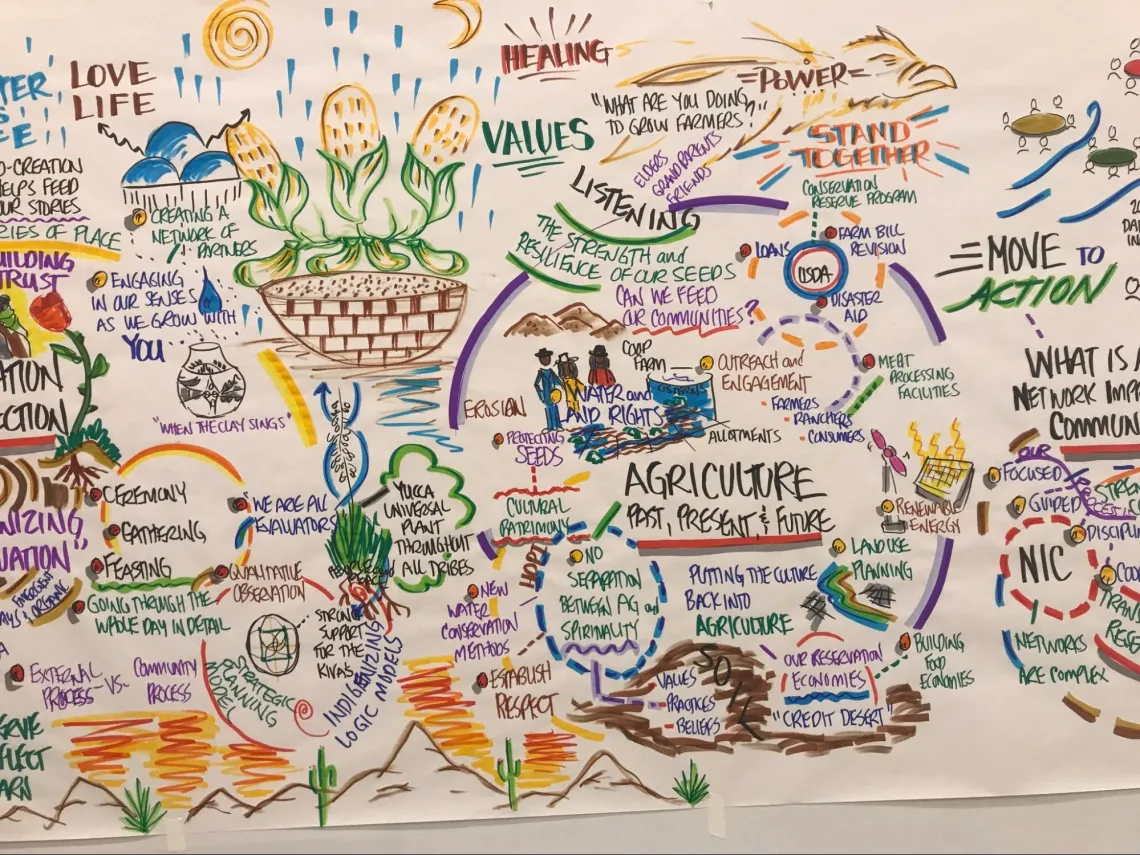
A section of a mind map drawn by artists Tim Corey and Derrick Gonzalez during the 2023 Native FEWS Alliance Annual Gathering. The mind map visually represents connections between major topics and themes discussed during community-led workshops and presentations. Photograph courtesy of Alexander Cotnoir.
For the last ten months, the inaugural Ilíiaitchik: Indigenous Correspondent Program cohort members dedicated themselves to crafting and publishing stories highlighting sustainable solutions and issues facing their communities. The ten students, representing eight tribes and five universities, also participated in monthly workshops led by Indigenous communication experts, delving into subjects from podcast production to photojournalism. In March, the correspondents embarked on an experiential learning trip to Tohono O’odham Nation, where they learned about pressing food, water, and energy challenges faced by Native Nations in the southwest and across Turtle Island.
As a culmination of their experiences, the cohort traveled to Nacotchtank and Piscataway-Conoy homelands in Washington, DC, to attend the 2023 Planet Forward Summit in April. The two-day Summit, hosted by Planet Forward - a multimedia environmental storytelling platform and initiative based at The George Washington University - attracted over 200 in-person attendees and engaged another 400 online participants through panel discussions led by industry experts, environmental communication workshops, and networking opportunities among students, faculty, and communication professionals interested in tackling climate change and environmental justice issues.
This year's Summit theme - “All In: Diverse Voices, Compelling Narratives, and Sustainable Solutions” - deeply resonated with the Ilíiaitchik cohort. Throughout the program, each member actively aimed to highlight solutions and stories from their communities; communities historically excluded from environmental communication spaces and narratives.

ICP Team members pause for a group photo at the 2023 Planet Forward Summit at The George Washington University in Washington, DC. Photograph courtesy of Lisa Palmer.
During the Indigenous Correspondent Program’s time onstage for their “Native Knowledge and Narratives” panel, Kaly Arvizu, a Diné Indigenous Correspondent from Tuba City, Arizona, spoke about the critical need for Indigenous inclusion in environmental spaces. Currently pursuing a Social Work degree with a minor in Community Engagement at Northern Arizona University, Kaly emphasized that, "Indigenous Peoples, our cultures, and the things we hold sacred are intersectional with every other fight that’s occurring, especially the fight to save our planet... therefore it's imperative to listen to the solutions of the original people who’ve lived here harmoniously for thousands of years and stand in solidarity with us.
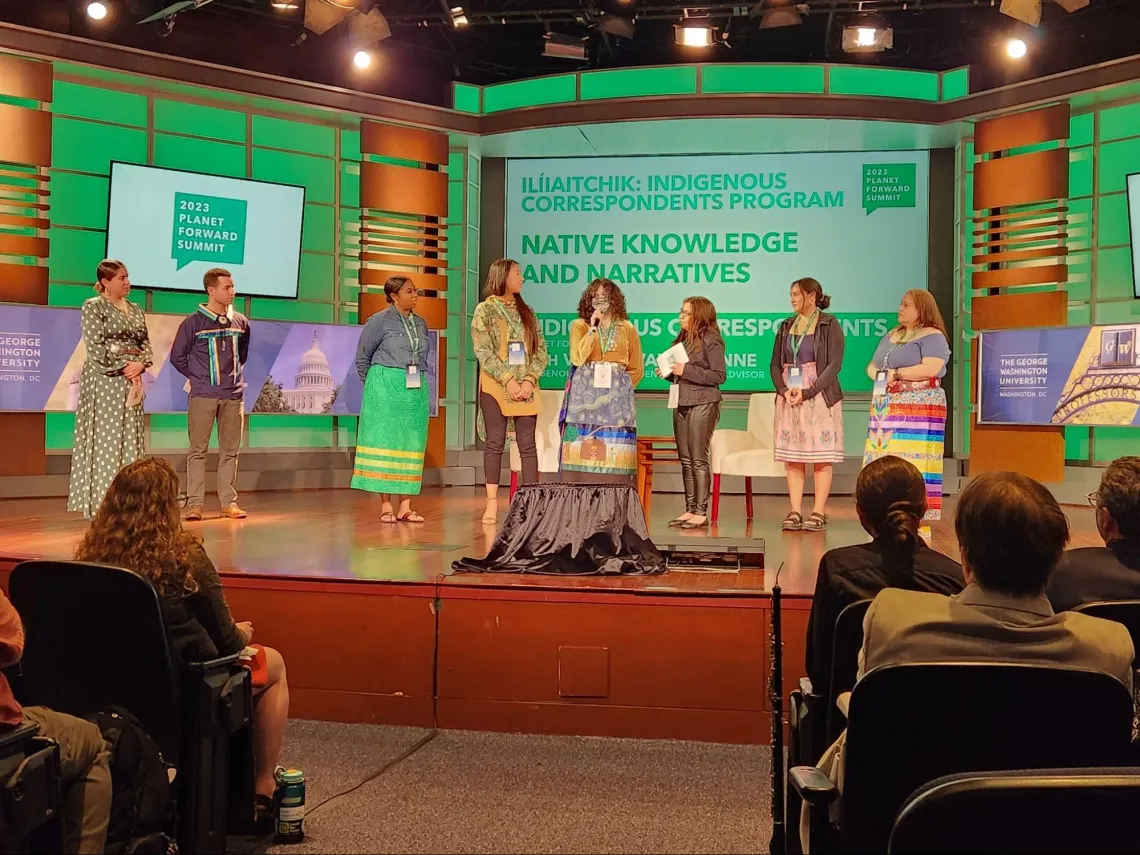
Kaly Arvizu (pictured at center holding the microphone) speaks about the importance of learning from, and standing in solidarity with, Indigenous communities during the “Native Knowledge and Narratives” panel, facilitated by ICP Editor Valerie Vande Panne. Photograph courtesy of Maria Johnson.
Katie Orlinsky, A National Geographic Contributing Photographer, echoed Kaly’s sentiment of centering Indigenous voices, perspectives, and concerns in conservation and land stewardship decisions later at the Summit while presenting her photographs and describing the process by which she co-created an upcoming National Geographic story about vanishing caribou in the Arctic.“Working on this story, it's become clear that, if we want to save the caribou, we have to look to and listen to the (Indigenous) people who know them best… I also think the days of someone like me telling these kinds of stories are probably over…all these kids that I’m teaching, they’re going to be the ones to tell these stories in the future.”
As Orlinsky explained, Arctic caribou populations have plummeted from 5 million to 2 million individuals in just 20 years, marking one of the most rapid declines of large land animals since the American buffalo, which has profoundly impacted Indigenous communities across the continent. Orlinsky's presentation, “Pictures from the Frontlines of Climate Change,” especially resonated with Indigenous Correspondent Shondiin Mayo, whose family is from Stevens Village in northern Alaska and is familiar with caribou. While Orlinsky described the negative impacts of caribou declines and the cultural, spiritual, and nutritional importance of caribou for Indigenous Alaskan and First Nations communities across the Arctic, Shondiin mentioned “I’m actually wearing caribou-tufted earrings today.”
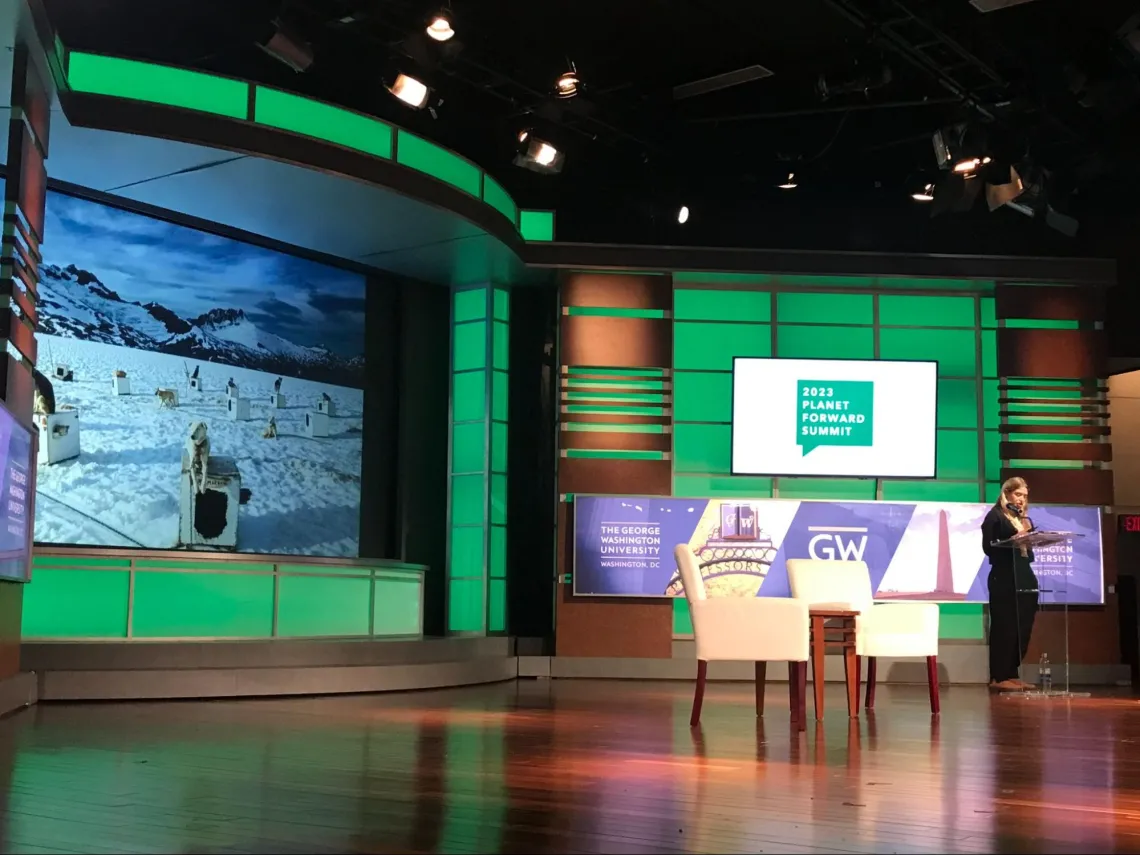
National Geographic Contributing Photographer Katie Orlinsky describes her experiences collaborating with Alaska Native and First Nations communities across the Arctic to tell stories of environmental change. Photograph courtesy of Alexander Cotnoir.
As a non-Indigenous reporter who didn’t grow up in the Arctic, Orlinksy explained that her storytelling process requires an immersive approach built on mutual respect and trust, which led her to live for months at a time with various Indigenous communities, including the Inupiaq village of Kaktovik and the Neets'aii Gwich'in community of Arctic Pass. “I never enter a community unless I have permission and I'm invited,” said Orlinsky, who also gives back to community members during her stays by conducting photography workshops for youth. As Orlinksy explained, “The (Inupiaq) kids in Anaktuvuk Pass have been documenting the spring caribou migration (since two years ago)… we’re really excited to see their pictures and have them be a part of this National Geographic story.” Our group was excited to hear that Orlinsky is actively combatting the extractive tendencies of journalism, through maintaining relationships with communities and thinking of reciprocity in sharing knowledge and resources.
While Orlinsky’s storytelling and images highlighted the many threats caribou face amid climate change, arctic drilling, road development, and sports hunting, the cohort was particularly intrigued to hear her report on two Indigenous-led caribou stewardship success stories. Orlinsky explained how the Porcupine Caribou Herd in northeastern Alaska, stewarded by the local Neets'aii Gwich'in community, is the only herd in the Arctic that is growing rather than declining. Orlinsky attributed this localized success in part to the activism of Indigenous Gwich'in community members, such as Elder Sarah James, who have fought against oil development and drilling in the Arctic National Wildlife Refuge for decades.
At the end of her presentation, Orlinsky displayed an image on the screen of a young caribou calf being fitted by members of West Moberly First Nation and Saulteau First Nation with a radio collar in south-central British Columbia. Orlinsky explained how the calf stands as a testament to the determination and success of Indigenous-led caribou conservation initiatives, which have brought the local Klinse-Za mountain caribou herd (among other local populations) back from the verge of extinction.
Ten years ago, only 16 mountain caribou remained in the forests around West Moberly First Nation and Saulteau First Nation, leading members of both communities to launch a maternity pen program, which involves capturing and protecting caribou mothers and calves in a forested enclosure for monitoring and protection from predators until they can be safely released. Orlinsky explained that this Indigenous-led initiative has been a great success, enabling the Klinse-Za herd to grow from 16 to 114 caribou. "And not only that, but the Saulteau (First Nations) and West Moberly (First Nations) secured a landmark conservation agreement that protects over 3,000 square miles of caribou habitat… These communities are part of a growing Indigenous movement to save species, preserve landscapes, and return ecological stewardship to Indigenous people," Orlinksy said.
After her presentation, Orlinsky spoke with several members of the Indigenous Correspondents cohort, including Shondiin, who recognized several people Orlinsky had partnered with for her “Vanishing Caribou” story. Reflecting on the presentation, Shondiin mentioned that it was exciting to see some familiar faces on the screen, especially so far from Alaska.

Katie Orlinsky (far right) describes how Indigenous community members have implemented creative solutions to curb declines in caribou populations, while showing a selection of photographs taken by community members (pictured on the screen at left) submitted to help document the annual caribou migration. Photograph courtesy of Alexander Cotnoir.
Thursday's Planet Forward Summit festivities began with Indigenous Correspondent Troi Madison Newman, a first-year law student at the University of Arizona and enrolled member of the Piscataway Conoy Tribe of Maryland, leading a Land Acknowledgement. Troi prompted attendees to reflect on the fact that the event was taking place on Indigenous lands, saying, “Today we honor, with gratitude, the land itself and the people who have been stewards of this land throughout the generations. Piscataway translates to the people of the waters… reminding us that clean air and waters are essential to life. This land acknowledgment is a vocal reminder to each and every one of us, that our physical environment is embedded with traditions that we have inherited for better health and prosperity.”
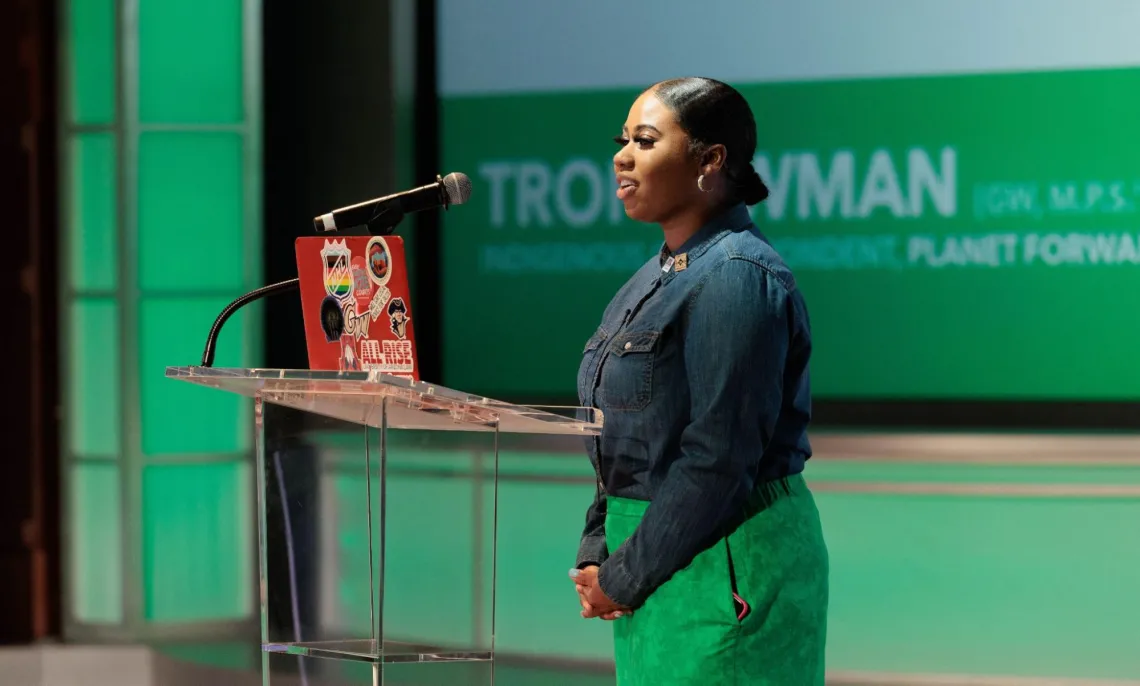
Troi Madison Newman, a Planet Forward Indigenous Correspondent, enrolled citizen of the Piscataway Conoy Tribe of Maryland, and University of Arizona law student, delivers a Land Acknowledgement at the beginning of the Planet Forward Summit. Photograph courtesy of Planet Forward.
Following Troi’s opening remarks, Ed Maibach, Director of the George Mason University Center for Climate Change Communication, discussed public perceptions of climate change severity and how different segments of the US population view its root causes. Matt Scott, Director of Storytelling and Engagement at Project Drawdown, highlighted the power of personal stories in bridging the psychological gap in addressing climate change, while a panel discussion among Gabrielle Gurley (The American Prospect), Ashley Walker (the Climate Reality Project), and Maria Zaharatos (Middlebury Institute) focused on advocating for individual stories. (You can view a list of the 2023 Planet Forward Summit’s speakers here.)
Artealia Gilliard, the Environmental Leadership and Sustainability Director at Ford Motor Company, was one of the keynote speakers who drew interest from the cohort. In her presentation, Gilliard delved into the challenges and possibilities associated with electrifying the American automobile industry. Drawing from her previous experiences working with rural and Alaska Native communities during the Obama administration, she emphasized the significance of considering localized impacts when discussing energy transitions. Before her role at Ford, Gilliard worked with local and Alaska Native communities as part of the Bureau of Land Management in Alaska, advocating for their voices to be heard in natural resource management and energy development decisions. Several correspondents were particularly interested in Gilliard's discussion on the interconnectedness of energy security, climate change, and rural livelihoods, considering that some stories shared by the correspondents themselves focused on these topics, including Shondiin's story, titled “Indigenous energy and equations.”
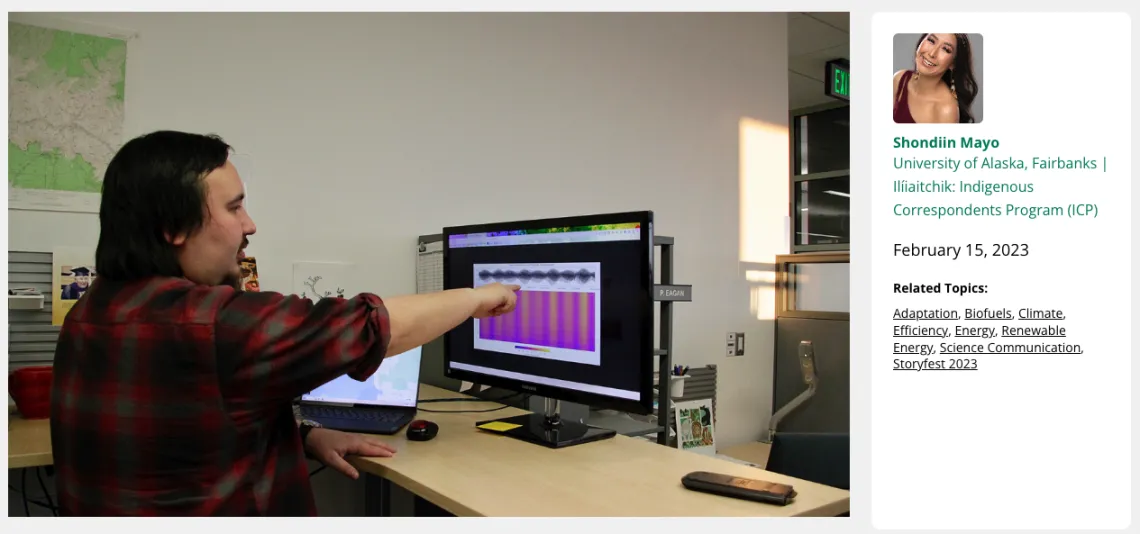
Bax Bond, a Yupik research engineer at the Alaska Center for Energy and Power, points to an energy balancing model at his workstation. This image, courtesy of Shondiin Mayo, is from her story titled “Indigenous energy and equations.”
To conclude the Planet Forward Summit, the cohort celebrated the recognition of three Indigenous Correspondents whose stories were selected as finalists in Planet Forward’s annual Storyfest contest. The three finalists from our cohort included JoRee LaFrance (University of Arizona) with “Crow Cowboys: A story of responsibility, respect, and resilience,” selected as a finalist in the Most Compelling Character category; Raylen Bark (Dartmouth College) with “Indigenous plant sovereignty and Cherokee culture,” recognized as a finalist in the Most Creative Story category, and Shondiin Mayo (University of Alaska Fairbanks) with "Indigenous energy and equations," selected as a finalist in the Best Use of Science or Data category. While our cohort members did not secure a trip to Iceland this year, we couldn’t be prouder of their nominations among the over 140 stories submitted!

Stephen Yellowtail, an Apsáalooke rancher, poses with some of his horses in Crow Country. This image, courtesy of JoRee LaFrance, is included in her photographic essay titled “Crow Cowboys: A Story of Responsibility, Respect & Resilience.”
Following the Planet Forward Summit, the cohort visited CNN’s DC headquarters for a behind-the-scenes tour led by CNN Washington bureau chief and senior vice president Sam Feist and Planet Forward’s founding director and former CNN anchor Frank Sesno. The tour provided a behind-the-scenes look at CNN’s broadcasting studios and story production areas and provided opportunities to learn about the evolution of broadcasting technology, such as the impact of live streaming, better sound equipment, and how these advancements have transformed on-site reporting practices.

Behind the scenes of CNN’s News Central film studio during the ICP tour. Photograph courtesy of Alexander Cotnoir.
On Friday evening the cohort attended the RiverRun Festival at the Kennedy Center for the Performing Arts. The festival, held against the backdrop of the Potomac River, celebrated the global significance of rivers, acknowledging their cultural importance and roles as essential lifelines and sources of artistic inspiration. After exploring art installations that shed light on the ecological value and challenges faced by rivers, the cohort was particularly captivated by the breathtaking view of the Potomac River curving around Analostan Island.
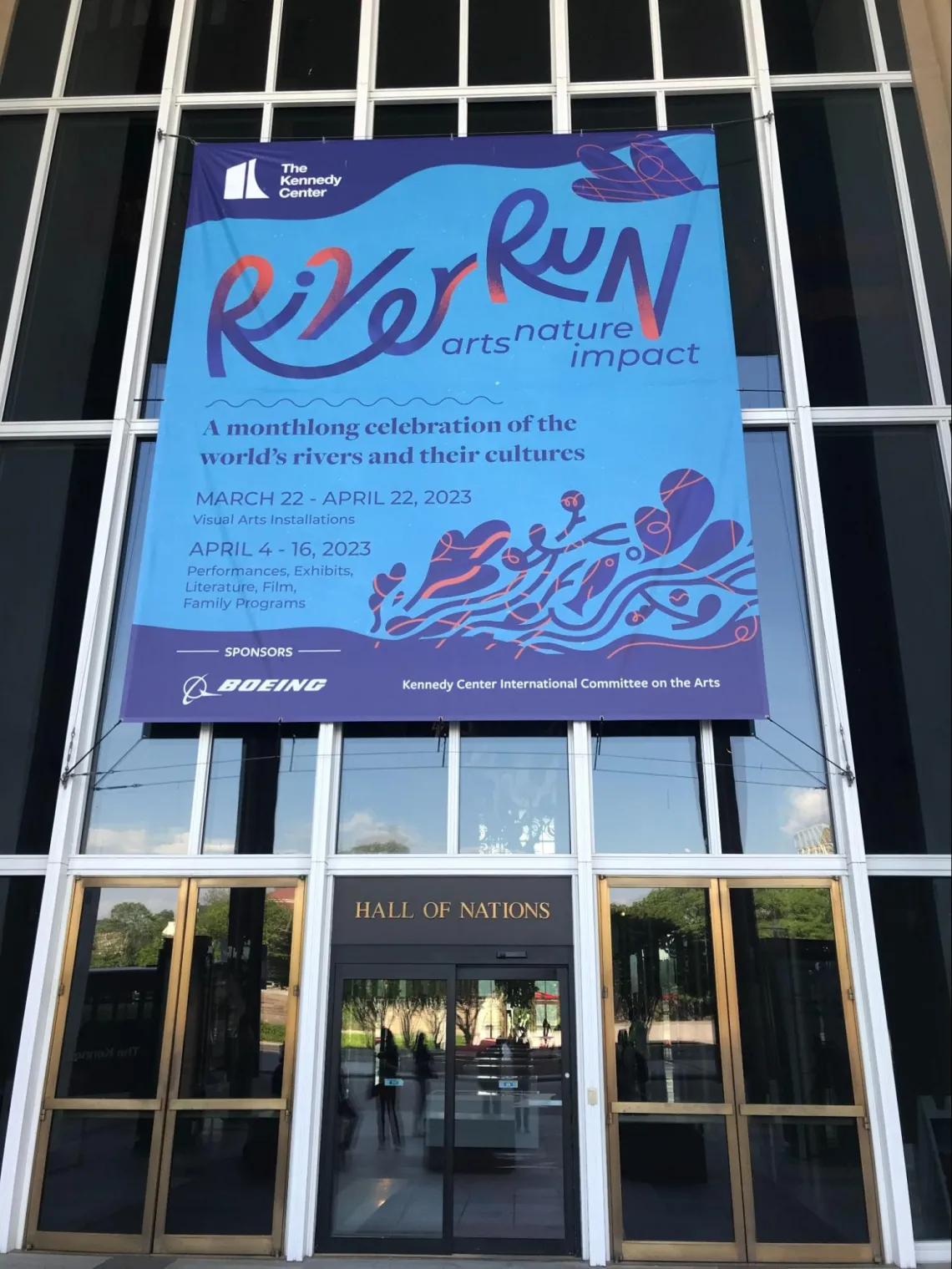
A banner above the Hall of Nations at the Kennedy Center for the Performing Arts announces the 2023 RiverRun Festival exhibitions. Photograph courtesy of Alexander Cotnoir.
From the top of the Kennedy Center, we paused to reflect on the significance of being in a place with a rich Indigenous history that has often been overlooked and disregarded, even as new buildings and monuments were erected upon it. Analostan Island (today called Theodore Roosevelt Island and positioned across from the Kennedy Center) held great significance for local Indigenous communities before the arrival of European settlers, serving as a site for fishing, trading, and spiritual ceremonies. While we enjoyed the exhibits highlighting the Mississippi and Amazon Rivers, it was disheartening to juxtapose the conversations heard inside with the fact that many Washingtonians remain unaware of the ongoing struggles faced by Piscataway communities in their surrounding neighborhoods. These communities cannot fully exercise their treaty rights to fish along the Potomac and Anacostia Rivers due to pollution and development. Our visit to the Kennedy Center made the group even more resolute in our mission to share localized, community-driven stories that amplify important voices and raise awareness of these often overlooked but pressing issues.
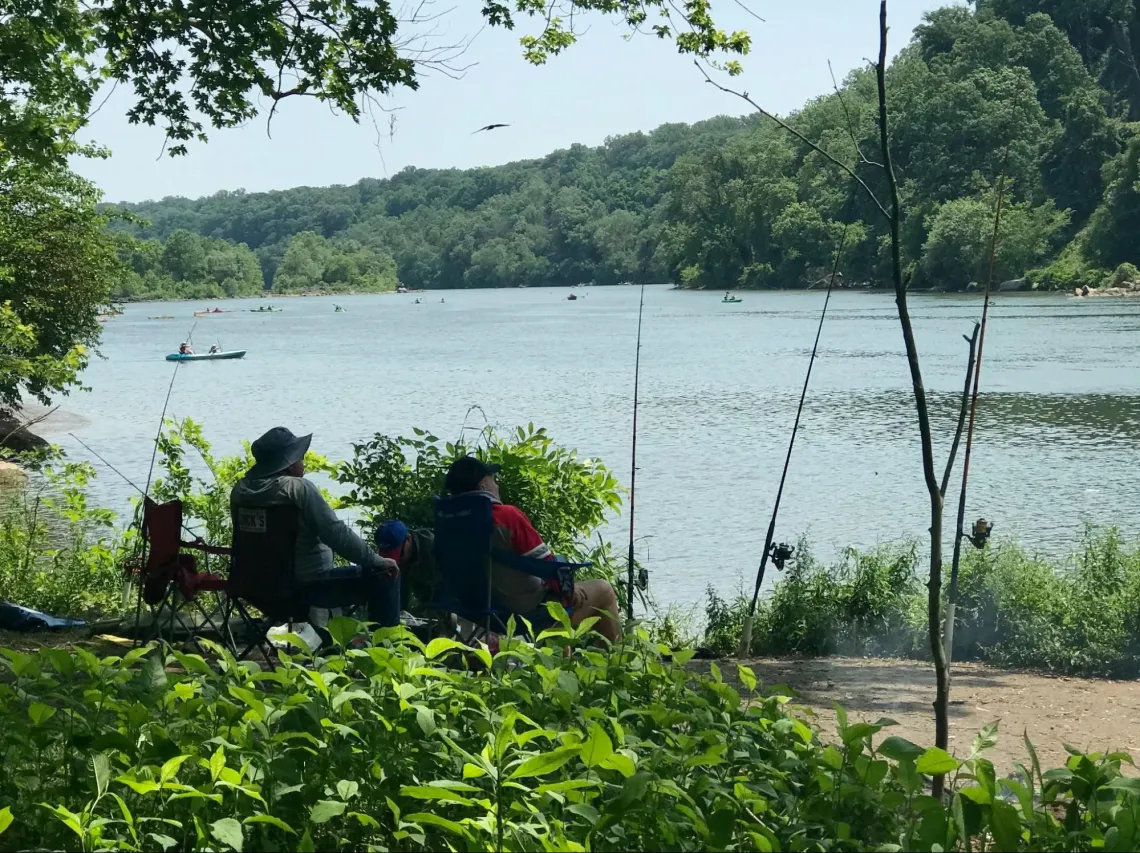
Fisherfolk and kayakers recreate on the Potomac River at Fletcher’s Cove, shortly upstream from Analostan Island, April 2023. In 1971, both swimming and wading in the Potomac, Anacostia and Rock Creek were officially banned in the district due to significant levels of pollutants in the waterways. Photograph courtesy of Alexander Cotnoir.
For their final day in Washington, DC, the cohort attended the 2023 Living Earth Festival titled “Native Nations Confronting Climate Change”, hosted by the National Museum of the American Indian. The annual Living Earth Festival featured educational and art stations staffed by community members, along with guest speakers and panel discussions highlighting how Native Nations are addressing environmental challenges, including water pollution, food insecurity, biodiversity loss, and erosion.
During the festival, Alisa Smith Woodruff, an Indigenous Correspondent and Skokomish – tuwaduq citizen pursuing her master's in Environmental Studies at Evergreen State College, and I spoke with Nicole Norris (Xelaltxw) at the "Sea Gardens of the Pacific Northwest" station. After an introduction to clam gardens constructed by First Nations and Indigenous communities along the Pacific coast, Alisa explained to me how these sophisticated sea gardens, built according to ancestral knowledge, significantly increase clam habitats, ensuring a more reliable food source. Alisa also explained traditional clam cooking practices, which sometimes involve placing the clams on fire-heated stones and burying them underground to slowly steam them.
Following our discussion by the clam “sea gardens,” we stopped by several other booths in the Potomac Atrium to learn about initiatives in the southeast and the Hawaiian Islands promoting food sovereignty and security. We spoke with Kaben Smallwood, Andrea Nicole Smallwood, and Heidi Marie Couch about a Choctaw-led aquaponics program, as well as with Makua Perry (Native Hawaiian) from the Malama Loko Ea Foundation about Hawaiian taro terrace gardening and fishpond systems. Perry highlighted the challenges facing traditional Hawaiian fishponds, which are crucial for cultural continuity and food security on an island heavily reliant on imported goods. While many traditional fish ponds have been destroyed or unmaintained due to the colonization of the Hawaiian Islands, efforts are underway to restore these traditional aquaculture ponds, promoting sustainable food sources and economic opportunities rooted in Hawaiian culture.
After our visit to the National Museum of the American Indian (NMAI), the Indigenous Correspondents cohort joined Grace Anderson, an Education Specialist at the United States Botanic Garden (USBG), for a walking tour to learn about the garden's recent (Plants and Climate Change Education (PLACCE) initiative and the USBG's efforts to raise awareness about environmental and climate change issues among the general public.
Following Grace, we explored the gardens and paused at various plants to discuss the significant impact of climate change on species like the arabica coffee tree, a widely consumed and economically important coffee species. Standing beside a tree with plump orange pods growing along its trunk, Grace explained how rising temperatures, shifting rainfall patterns, and the increased prevalence of pests and diseases all pose threats to this culturally and economically significant crop. Grace then highlighted how scientists are turning to local wild arabica coffee varieties to develop more drought-tolerant coffee cultivars.
After visiting several other plants along the tour, Grace introduced the group to the Garden's current gallery exhibit "Cultivate: Growing Food in a Changing World." This exhibit examines the interconnectedness of people, communities, and food production, emphasizing how growing and cooking food can foster a sense of connection. It also showcases innovative approaches that promote sustainable food production in response to our changing world.

ICP cohort members and University of Arizona students learn about how climate change is impacting coffee growing regions of the world as Grace Anderson (not pictured) explains the benefits of wild arabica coffee cultivars. Photograph courtesy of Alexander Cotnoir.
After our transformative year together culminating at the Planet Forward Summit, I've been reflecting on the remarkable achievements we accomplished during our inaugural year of the program. With unwavering support from the dedicated teams at Planet Forward and the University of Arizona, we transcended geographical boundaries, navigating disparate time zones, community commitments, and demanding work and study schedules to learn and craft stories together. In the process, we wrote or recorded breathtaking narratives and met with extraordinary mentors who shared their stories and knowledge with us. To everyone who spoke with the group - I am incredibly grateful. Beyond the accomplishments of publishing stories and speaking at the Native FEWS Alliance Gathering and the Planet Forward Summit, what truly resonated with me is the bond we forged as a community. We created a space where we uplifted one another and shared stories that held deep personal significance. Standing side by side on stage at the Planet Forward Summit was a fitting way to conclude this journey. It was a nod to what this program is at its core - a space to amplify diverse narratives and share those stories - together.
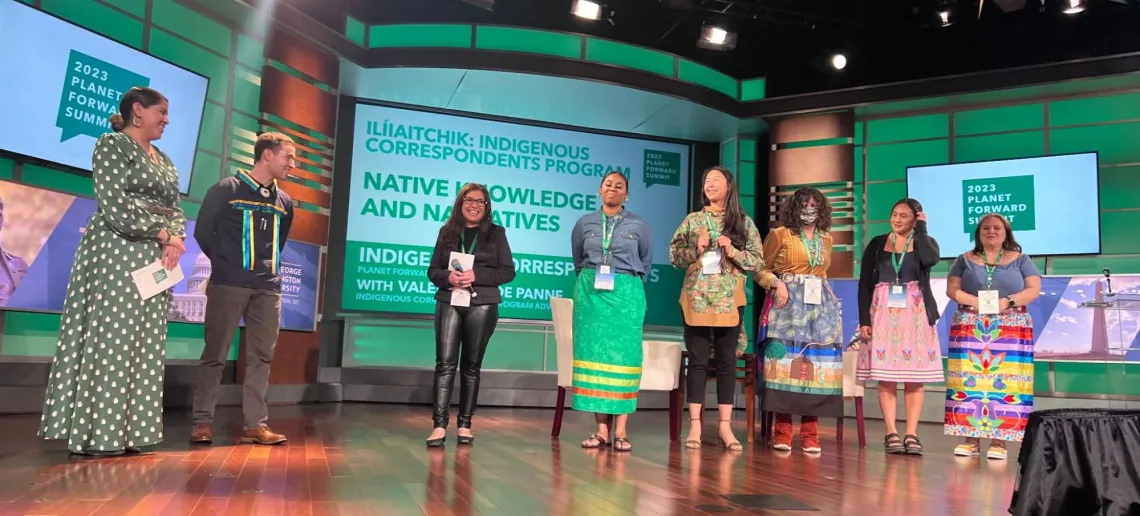
The ICP team reflects on their year spent together at the close of their panel discussion at the Planet Forward Summit. Photograph courtesy of Planet Forward.
